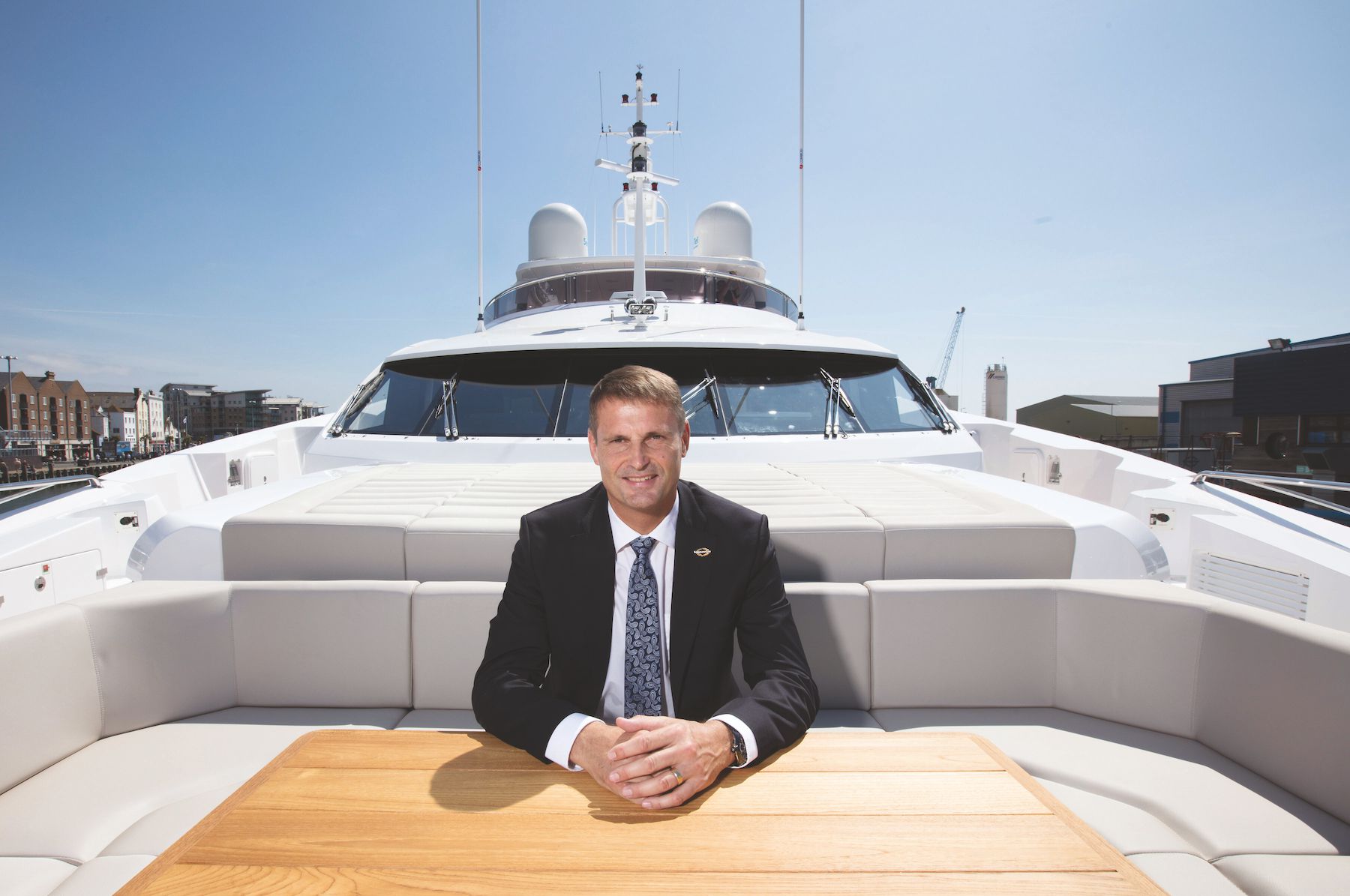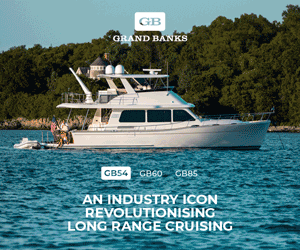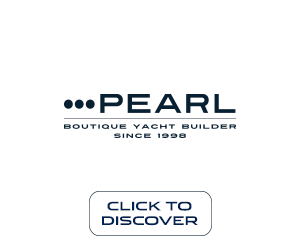Sitting down with Sunseeker
Q&A with Phil Popham, CEO of Sunseeker.
19 November 2017
From humble beginnings, Sunseeker have evolved from being a brand, to a global icon. Producing the finest motoryachts the world has ever seen, every Sunseeker is the result of an uncompromising and unmatched approach to design, craftsmanship and performance.
Manufactured in Poole on the south coast of England, Sunseeker employ over 2,200 people and is represented on every continent by a network of distributors. Available from 40 – 155 feet, the Sunseeker range constantly set new standards and benchmarks. Never settling for second best, it’s this spirit of excellence that has driven Sunseeker to its pre-eminent position in the marine market today.
Sunseeker International’s CEO Phil Popham sat down with Esther Barney at the Cannes Yachting Festival to discuss plans for the future direction for the British yacht builder, including a dealer network expansion in Asia, its £50 million investment plan and staying ahead of the competition when it comes to new designs.
What is driving the new design of the boats you are creating at Sunseeker now?
There are a number of factors. We have to listen to our customers in terms of what they want from their boats, and that influences a lot of the features on board. Many of our clients are focused on how they are using outside entertainment areas such as the beach club, so we developed this in the Manhattan 52 and 66, as well as the newly revealed Predator 57 MkII. There’s also a huge social area in the bow because, when they are tied up stern-to in a marina, our clients want privacy. The flybridge is also very large as, when you are out at anchor, that’s the place you want to be. On the smaller boats, we have what we call the “inside out” feature, where you can drop the doors into the floor to make one big outside area, or you can close it up if you want cockpit air conditioning.
Another driving factor is making sure we have a “Sunseeker family” look for all our boats.
The tall window graphics which are now typical of all our boats, with floor-to-ceiling windows, that’s a distinctive design cue which says “Sunseeker”. It also provides a light and airy feeling within the interior, so it has a practical use for the customer, too.
Performance has always been part of our heritage. Over the years, people would buy a Sunseeker because they knew they could get back to the marina first and be the fastest boat. Our brand proposition is focused around a combination of design, performance and craftsmanship.
How much do you pay attention to what the other yards are doing in terms of their designs?
We have our senior engineering team spending two days here at Cannes Yachting Festival touring the port, looking at technology, ways of building and features that stand out. We will have a meeting when we get back to the shipyard, with a debrief from both the Cannes and Southampton shows, to review what we saw, what we liked and any defined trends.
What is currently the greatest challenge for you as a builder?
The industry went through a really difficult time in terms of the recession, and the business was losing a lot of money just three years ago; but we took it back to profit in 2016. We have had to look at the material cost of building boats, labour efficiency and revenue. It’s about looking at every aspect of the business to take it back into a sustainable profit.
Regulations are always changing, in respect to emissions these changes mean that after-treatment on engines takes up more space in the engine room and has an impact on design. Crew living space regulations mean we must build allowances for this into the design. And customers want more and more features and toys, perhaps for less money or for less space and weight. Unlike when you are building a house and you can specify any materials that you want – from marble floors to granite worktops – you can’t do that on a boat because you have weight concerns, and every time you add a new feature, because the boat has to float and balance, you have to add ballast for it as well.
Saving weight is a real focus for us at the moment because if you can reduce weight, you can put a smaller engine on the boat, which gives more efficiency and more range, at lower cost to the customer.
Sunseeker’s retail sales grew by 25 percent in 2016. What would you say has been the biggest impact on this?
New product investment has had a big impact; we had five new product launches last year, including the Manhattan 52, which is our fastest ever selling models; and we continue to add design refreshes. We put in a lot of work in terms of consistent brand positioning, both in the look of the boats as well as our communications strategy, including the “Seek More” campaign.
Representation has also been important. We have hired new dealers in North America, across Europe and the Middle East. We have filled in gaps and taken out one or two dealers that were not performing. All our dealers have signed new contracts that are consistent in terms of standards in sales and after-sales, as well as the way they portray and represent the brand. All these things combined mean that we have a very healthy order book.
The market in the US has been one of the strongest to return and we have been building our dealer network there. We are now focusing our attention on Asia. We have done well in the region over the last couple of years, and especially in 2017. The big unknown is where the Chinese market is going because that is still very small. They haven’t fallen in love with boating, but they will do at some point. We have good representation in Hong Kong, Thailand, Singapore and Japan; and we will appoint more dealers in time.
You have committed to investing £50 million into the business over the next few years. How do you maximise your investments and choose where to direct funds, as a company?
The important thing is to have a long-term plan. We currently have a five-year business plan, a five-year product plan and a five-year representation plan. We need to make management judgement in terms of where the market is going and which segments are developing.
Every pound that we spend has an opportunity cost; you can’t do everything, so you have to make choices. The decision is usually based on whether the segment is growing and if we could add a model in the segment that is true to Sunseeker’s brand values of design, performance and craftsmanship. If the answer is yes, we will look to do that.
We have a plan to replace all the products that we have in the range and to expand it, driven by that long-term judgement. Over the next five years, we will be investing as much into facilities as we are into the product. We are going to change some our the methods of build to make the process more efficient and consistent, which will reduce cost and improve quality across the range. It takes anywhere between three and 13 months to build a Sunseeker, and it is very labour intensive. So we have to plan production capacity effectively.
How does your car industry background with 25 years at Jaguar Land Rover help with this?
It has certainly helped in terms of discipline, governance, process and long-term planning. I have taken all my learnings from Jaguar Land Rover and applied it with Sunseeker.
Given your Chinese investment backing, do you have any concerns about growing government restrictions for foreign investment that may be imposed in the future?
There’s been a lot of speculation around the key Chinese companies that are investing heavily abroad. Sunseeker benefits from ownership of Dalian Wanda Group because it provides guarantees to access loans from the market. We borrow working capital from a British bank and we have adequate funds for the next five years to fulfil our business plan. We foresee no impact from whatever scrutiny or restrictions might be imposed by the Chinese Government on Chinese companies.







